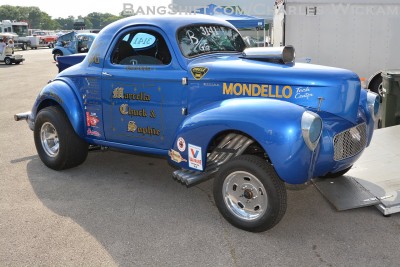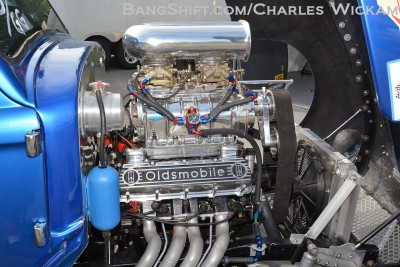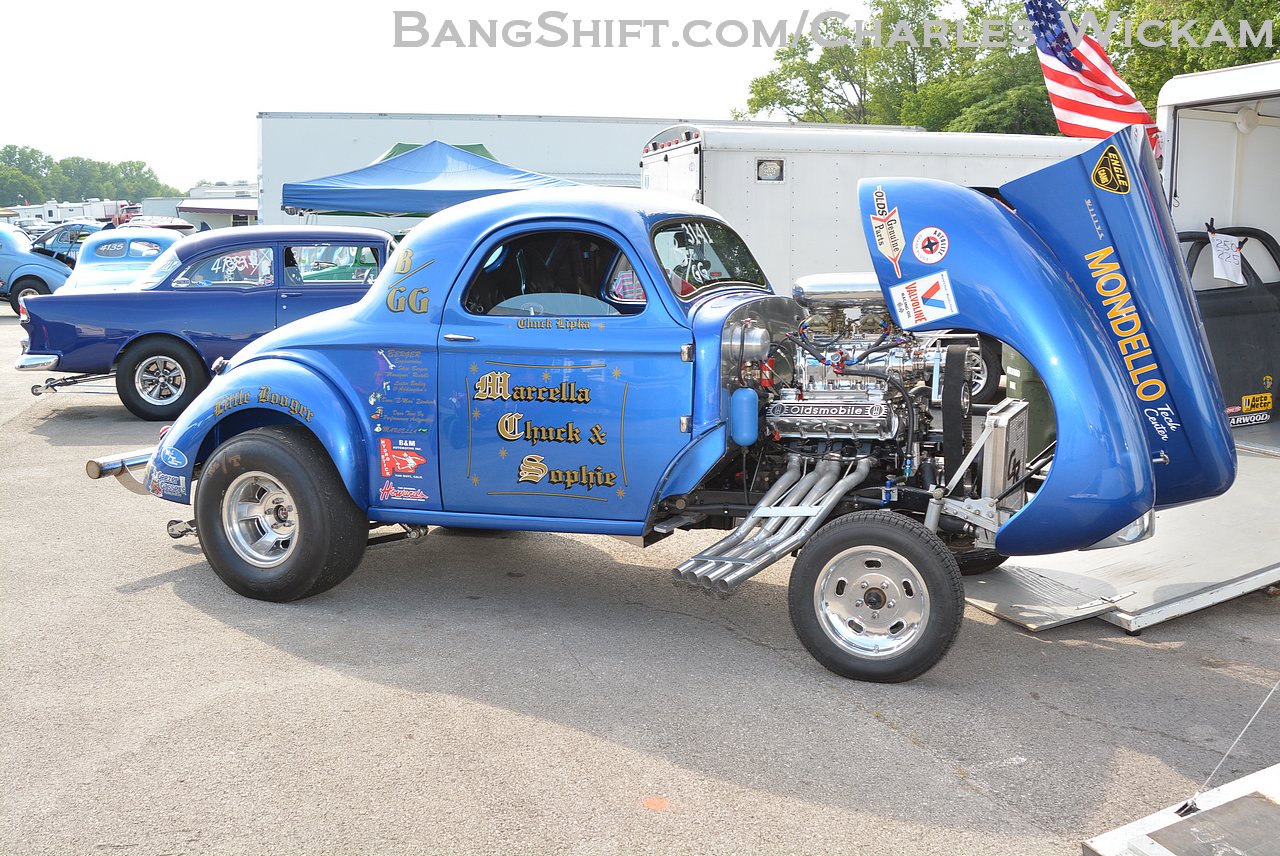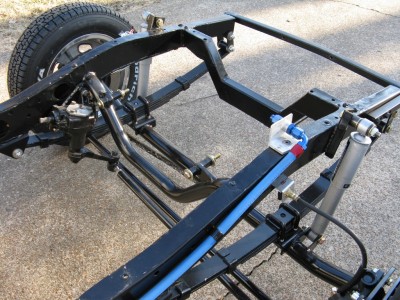There came a point where the engine needed a freshening and the car some updates. Wife and I looked hard at this…..we knew what the steel car is worth, knew what it was going to take dollar wise for the freshening, and we made a decision to take our update budget and add a bit to it and build a new car……a dedicated race car that would allow for some important “do overs” from the steel car. I specifically wanted a better cage, both in design and materials, I wanted to build the new car a bit lighter than the steel car, and I wanted an upgrade in the engine……more power and torque on less cubic inches. Of course, more power……….think Tim Allen.
 While at the March Meet one year, I mentioned to a friend from Phoenix I was in the market for a ‘glass body as a starting point for a new car. I didn’t feel like I could justify the cost for one of the main stream street rod bodies that were so popular at the time, but I was really not wanting one of the “off brand” nightmares that I had seen that all required a ton of prep work. My buddy from Phoenix put me in touch with the owner(s) of a ‘glass body he knew of, and negotiations began. Problems arose, as the two brothers who owned the body couldn’t agree on a price…….just like they couldn’t agree on what format to build the body causing the original project to stall……one wanted a gasser look, the other wanted a pro street car. Negotiations continued over the next 3 months, on and off, with the brothers still disagreeing. In the midst of all this, a second buyer entered the picture, offering stupid money for the body and that deal was struck.
While at the March Meet one year, I mentioned to a friend from Phoenix I was in the market for a ‘glass body as a starting point for a new car. I didn’t feel like I could justify the cost for one of the main stream street rod bodies that were so popular at the time, but I was really not wanting one of the “off brand” nightmares that I had seen that all required a ton of prep work. My buddy from Phoenix put me in touch with the owner(s) of a ‘glass body he knew of, and negotiations began. Problems arose, as the two brothers who owned the body couldn’t agree on a price…….just like they couldn’t agree on what format to build the body causing the original project to stall……one wanted a gasser look, the other wanted a pro street car. Negotiations continued over the next 3 months, on and off, with the brothers still disagreeing. In the midst of all this, a second buyer entered the picture, offering stupid money for the body and that deal was struck.
I was back on the search, when the guy who made the deal on the body called, offering it to me. Seems his first choice was a steel body, but he settled on the ‘glass one because he was unable to locate a steel piece, and he was in a hurry to have a car. As luck would have it, my buddy from Phoenix had located this guy a steel shell, and he now wanted rid of the ‘glass to build the steel car. I had a bunch of steel pieces from my original build (what he needed) so a deal was struck for pieces and cash. A road trip with my wife over a Memorial Day weekend (when we were off work) followed, the deal was made, and I had the starting point for the new car. The road trip was not without its “attention getters” the best (worst) being the body nearly exiting the open trailer I was using after an encounter with a pavement separation on the interstate in New Mexico. Seems the body was partially attached to a rolling chassis, and the chassis suffered a failure of a bubble gum weld. The tie down straps let go at the point of the weld failure, and the body/chassis began rolling backwards off the trailer. I caught it, secured things, and limped on, finding a truck stop along the way. The place had a welding shop on site, operated by a couple of brothers (Native American). I told them of my plight and when they saw the body, I immediately was a new friend….believe it or not, they recognized the shape of the body as a Willys, and hustled me right into the shop. During the repairs, it comes to light that their father had driven a Willys all over their home turf when they were young, and they both had in fact, learned to drive in it. No, it was long gone when I asked of its current whereabouts…..can’t hurt to ask you know. They finished the repairs, charged me NOTHING, and we were on the road again.
When we arrived at home, a buddy who was doing a steel car, began badgering me for the chassis this body was sitting on for his car.  There is a dramatic difference in frames between the ’37-’40 car and the ’41-’42. His steel car (’38) would not fit the ’41 sedan chassis he was trying to use. I decided I wanted more wheelbase the sedan chassis offered…stability/safety in mind. A deal was struck, and my build begins. Over the next 3 years, time and money permitting, it starts to take shape. I started by boxing the main frame rails, adding a couple of cross members, and repairing the frame horns front and rear to accept the leaf spring shackles. While I’m working on the chassis, the machinist I was using at the time started making upgrades and changes to the cylinder block. Since I was insistent on Olds power, and since the Olds diesel block is the piece of choice for a serious build, that’s where it started. Removal of the diesel specific castings, 4 bolt splayed main caps, and a general cleanup of flashing, were all on the list.
There is a dramatic difference in frames between the ’37-’40 car and the ’41-’42. His steel car (’38) would not fit the ’41 sedan chassis he was trying to use. I decided I wanted more wheelbase the sedan chassis offered…stability/safety in mind. A deal was struck, and my build begins. Over the next 3 years, time and money permitting, it starts to take shape. I started by boxing the main frame rails, adding a couple of cross members, and repairing the frame horns front and rear to accept the leaf spring shackles. While I’m working on the chassis, the machinist I was using at the time started making upgrades and changes to the cylinder block. Since I was insistent on Olds power, and since the Olds diesel block is the piece of choice for a serious build, that’s where it started. Removal of the diesel specific castings, 4 bolt splayed main caps, and a general cleanup of flashing, were all on the list.
I continued to gather engine parts…..serious pieces, as this was supposed to be a serious engine. Moldex crank, Edelbrock aluminum heads, J&E blower pistons, and a “serious” Mooneyham blower led the list. Over time, the list grew to include aluminum rods, a custom grind cam spec’d by Joe Mondello, to take advantage of the porting work he had done to the Edelbrock heads. Because this engine was not a 1 800 credit card small block Chevy, there were several starts and stops, redo’s and ‘aw shits over time. Eventually, it all came together, went to the dyno shop and surprised everyone with its power readings at relatively low rpm’s……all in @ 6300.
I continued on with the chassis, including the new leaf spring suspension, tube front axle, Vega cross steer, and rest of the powertrain, using a dummy block and empty transmission case to establish engine mounts/setback. The body was on and off the chassis a BUNCH of times, checking clearances, establishing body mounts, setting the placement for correct wheelbase, and countless other details. The body shell was just that, an empty shell. The doors and decklid were at a buddy’s shop, being prepped for hinges and latches.
Eventually, it all came together. The unpainted, raw ‘glass body was moved to a spare rolling chassis for work at the paint shop. I mounted and installed for the last time all the suspension, steering, and plumbing for the brakes and fuel system. When the body returned from the painter, it’s moved to the real chassis for the last time. The welder from a chassis shop that was suggested shows up and construction of the cage commences. Chrome moly is the material of choice, thinking back once again to the original plan of update and improvement. Stronger, lighter weight, and with the input from the welder, a much better design overall. The welder is an instructor for Miller at their commercial vendor displays, and a 10 year veteran of a big name chassis/fabrication shop. His welds are impeccable, without equal, and never fail to draw compliments.
All the details followed. Gauges, steering column, fuel system, electrical system were all time consuming, requiring help and and additional hands. After what seemed like an eternity with all the detail work, it was time for the big test. Yes, it started, ran, steered, and stopped, but the big test was still to come. We chose a Goodguys event at Norwalk in August 2009 for the debut. Accompanied by the overture from the movie “2001 A Space Oddessy” the car comes out of the trailer, introduced to the group for the first time. But not without a couple of glitches……..the transmission cooling lines wouldn’t seal, the fuel pressure regulator wouldn’t, and the slicks wouldn’t stay inflated. Finally, after several hours lying underneath this thing, the leaks were stopped, the regulator was replaced, and as a stop gap measure, the slicks were treated to the liquid soap deal. SUCCESS!!!!!!!!!!!
 With my heart racing, it’s into the staging lanes. As I make the turn to enter the water box, it’s now pounding. Fortunately, I’m able to calm down, pull into the water and do a “baby burnout.” All is good. Stage and launch….easy 400′ pass. Come back around. Repeat, this time, go 800′ before I shut down. It launches straight, goes straight, slows without issues, and generally feels good. Time for the real test. On the 3rd pass….the first “real” “semi serious” one, it goes an easy 11.39 @ 118. YEEHAAAAA!!!!!!!!!!
With my heart racing, it’s into the staging lanes. As I make the turn to enter the water box, it’s now pounding. Fortunately, I’m able to calm down, pull into the water and do a “baby burnout.” All is good. Stage and launch….easy 400′ pass. Come back around. Repeat, this time, go 800′ before I shut down. It launches straight, goes straight, slows without issues, and generally feels good. Time for the real test. On the 3rd pass….the first “real” “semi serious” one, it goes an easy 11.39 @ 118. YEEHAAAAA!!!!!!!!!!
Fast forward after a year and a half of thrashing, tuning, cussing and repairing, I’ve had the car chassis certified, I’ve run quick enough to quality for my NHRA License, and I’ve got a handle on this thing. It’s everything I had conceived and planned for. It looks like I wanted it to look. And, after a couple of false starts “learning experiences” and unplanned cash expenditures, it’s finished, to where you see it now.
Here are specifics:
1941 Willys coupe. A metallic blue color used by Mazda about 2009. NHRA permanent number 3141. It weighs a bit over  3,000#. ‘Glass body from Cutting Edge Technologies. This is not your generic hand laid ‘glass body. The body was in its time state of the art……it was done in 2 piece molds, with the polyester resin injected into the molds and heat cured, the same process used to make Corvette bodies. It uses balsa wood sheets as reinforcement in critical areas……floors, roof, doors, quarters. The 2 piece molds allow for uniform thickness of the ‘glass through out, a “finished” surface on both sides, and no gel coat to crack or distort during the curing process. The body was never a big seller……no shiny gel coat finish to polish up like Outlaw or Ida. It was a bit on the pricey side for its time, and not a big advertising budget. The manufacturer eventually quit and mothballed the molds. He is now producing the blades used by the wind generators that have become so prevalent. I decided to use exposed door hinges (unlike the majority of the ‘glass bodies) and exterior door handles, to make the car look “real”. Rain gutter/drip mouldings are on the shelf awaiting installation to complete the “deception.” The 4 piece front end is bolted together (I like the look of body lines like a “real”car) and hinged to tilt. Power windows were installed…..they really help with a bit of ventilation while sitting in the staging lanes. All the lights are functional, and it’s wired for a horn. AND, it’s legally registered and titled as a ’41 Willys…..could become someone’s street rod when I tire of the drag race scene.
3,000#. ‘Glass body from Cutting Edge Technologies. This is not your generic hand laid ‘glass body. The body was in its time state of the art……it was done in 2 piece molds, with the polyester resin injected into the molds and heat cured, the same process used to make Corvette bodies. It uses balsa wood sheets as reinforcement in critical areas……floors, roof, doors, quarters. The 2 piece molds allow for uniform thickness of the ‘glass through out, a “finished” surface on both sides, and no gel coat to crack or distort during the curing process. The body was never a big seller……no shiny gel coat finish to polish up like Outlaw or Ida. It was a bit on the pricey side for its time, and not a big advertising budget. The manufacturer eventually quit and mothballed the molds. He is now producing the blades used by the wind generators that have become so prevalent. I decided to use exposed door hinges (unlike the majority of the ‘glass bodies) and exterior door handles, to make the car look “real”. Rain gutter/drip mouldings are on the shelf awaiting installation to complete the “deception.” The 4 piece front end is bolted together (I like the look of body lines like a “real”car) and hinged to tilt. Power windows were installed…..they really help with a bit of ventilation while sitting in the staging lanes. All the lights are functional, and it’s wired for a horn. AND, it’s legally registered and titled as a ’41 Willys…..could become someone’s street rod when I tire of the drag race scene.
The chassis is an original 1941 Willys sedan piece. It uses a 104″ wheelbase, 2 inches longer than a coupe……specifically used for the extra length, for a bit more stability. The main rails and the X member rails were boxed with .100 flat stock. Additional cross members were added to the rear. The X member was notched for transmission clearance, and a drop out transmission mount fabricated. The engine area uses a combination dropped crossmember and engine mounts. The engine itself uses solid steel side mounts and an aluminum mid plate. The spring perches were fabricated to use 2″ wide leaf springs in the rear, 1/4″ wider than the original 1 3/4″.
Suspension is leaf spring all around, with the springs custom made by St. Louis Spring Co. The rears are 2″ wide with 6 leaves. A Cal Tracs system allows leaf spring usage without a “slider” arrangement or ladder bars. It also allows for some adjustability for preload/traction. The fronts are 1 3/4 in wide, 6 leaf. All springs use either custom made Delrin plastic bushings, or solid aluminum for the Cal Tracs.
Rear end is originally a ’64 Thunderbird. Axles are 35 spline, gun drilled from Moser. The center section is an aluminum piece from Strange, uses a lightened spool and a 4.11 Pro (big pinion) Richmond gear. The back up is a bolt through from Yukon, also a Pro gear, using a 4.30 ratio. Brakes are OEM Ford 11″x2 3/4.”
Transmission is a 400 Turbo, short tail shaft. It was upgraded internally by Cammed Up Racing, St. Louis) with an upgraded sprag, center support, and clutches. It uses a reverse pattern valve body and NO trans brake.
Converter is 9 1/2″ 4500 stall from Coan. It was spec’d by them using cam specs, car weight, and dyno sheets.
Wheels are Pat O’Brian’s Real Rodders Wheels. 15×10 rear with Mickey Thompson 29.5×10.5×15 slicks. The fronts are 15×4 “kidney beans” also Real Rodders Wheels, with 155 80R-15 BFG Radial T/A tires.
The current engine is a second go around. The first established the basic platform for the build. It’s based on an Olds (early 80’s GM family) diesel block, the piece of choice for any serious Olds build due to material quality (high nickle content), strength of the main web/crankcase area, and thickness of the cylinder walls. It was done by Berger Engineering of St. Louis……now retired and out of the business. The first engine suffered a catastrophic failure in the water box @ the California Hot Rod Reunion in 2011.
This current piece comes out of the shop of Morley Performance, St. Louis. It includes the basics and leftovers from the first one, as well as some new additions and updates. It includes:
Diesel block 4.125 bore
Moldex crank 3.750 stroke……..yeilds a touch under 400 cu in.
Edelbrock aluminum heads ported by Joe Mondello. 2.07 intakes/1.680 exhaust
Engle cam custom grind spec’d by Mondello to coincide with his head work…flat tappet/solid lifters
J&E blower pistons….8.0 static compression
GRP aluminum rods
Jessel shaft rocker system
Comp springs and retainers, Comp 3/8 pushrods
Dyers Machine blower intake….custom fabbed
Mooneyham blower……teflon stripped rotors……at 1:1 drive, makes about 13# boost (indicated)
Holley 850 cfm double pumper carbs……modified by Morley performance
Paint and body work was a group effort. It was started by Roy Cramner from St. Louis. Personal issues caused him to leave the project after the primering and “cutting in” the jambs and window openings. The final paint was done by Lester Bailey at Addington’s Farm and tractor restoration in Albany IN. The graphics are computer generated reproductions from Pfitzinger Graphics of St. Louis. The first choice was hand lettered gold leaf like “back in the day” with old style “water slide” decals. Availability, time, unable to locate a hand “letterer” as well as the old bugaboo $$$$$$$ prevented this.
Best performance(s) 1/8 mile 6.10/118 mph @ Sikeston (MO) Dragway April 2013
1/4 mile 9.77/138 mph @ Bowling Green (KY) Fall 2010

















Very nice
When you’re ready to sell this masterpiece let me know!
[email protected]